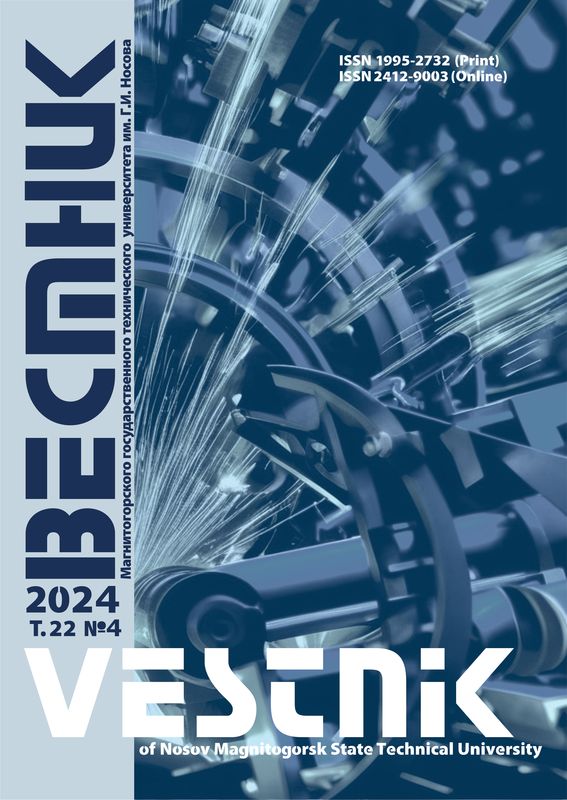Abstract
This work is aimed at expanding the application and improving numerical experiment-based studies of heat treatment processes extensively applied to non-inert materials in rotary kilns.
The purpose of the research is to develop new com-puter-oriented algorithms for the calculation of convec-tive heat transfer coefficients used to build heat balance equations applied in the zone method simulation of heat transfer processes that take place in kilns. The article describes a case of carbon materials calcinated in parallel-flow and counterflow modes and demonstrates an algorithm building procedure for the convective heat transfer coefficients identified, first for volumetric gas zones and subsequently for surface zones. Unlike the algorithms used before in heat treatment simulation of inert materials, these new algorithms account for the convective flows resulting from stripping volatiles from the treated material and the interaction of the material and the volatiles with the gas flow. The algorithms designed for volumetric zones are identical for the parallel-flow and counterflow modes. As for the surface zones, some of the equations included in the algorithms are different.
The article presents numerical experimental data for a petroleum coke calcination process which were ob-tained with the help of the developed algorithms and computer software. The accuracy of the improved math-ematical model was verified by means of parametric identification based on actual kiln data. Deviation of the calculated parameters from the actual process parameters is less than 5%. The research was carried out by the Department of Theory and Automation of Metallurgical Processes and Furnaces of the North Caucasian Institute of Mining and Metallurgy in 2014 and 2015. The mathematical model and the software are effectively applied in numerical experiment-based research. The advanced comprehensive mathematical model designed for heat treatment processes of a rotary kiln and the software developed for the above model can be used to study a broad range of heat treatment processes applied to both inert and non-inert materials in rotary kilns.
Keywords
Carbon materials, calcination, rotary kiln, mathematical model, algorithm, convective heat transfer, identification, numerical experiment.
1. Arutyunov V.A., Bukhmirov V.V., Krupennikov S.A. Matematicheskoe modelirovanie teplovoy raboty promyshlennykh pechey [Mathematical modeling of the thermal performance of industrial furnaces]. Ed. Arutyunov V.A. M.: Metallurgiya. 1990, 240 p.
2. Meshkov E.I. Developing the theory and improving the technology for production of graphite electrodes based on mathematical models of mass and heat transfer. Aftoreferat dissertatcii doktora tekhnicheskikh nauk [Abstract of a doctoral dissertation]. Vladikavkaz: North Caucasian Institute of Mining and Metallurgy, 2009.
3. Arunyants G.G., Rutkovskii A.L. Matematicheskoe modeliro-vanie v zadachakh proektirovaniya sistem upravleniya slozhnymi obyektami [Mathematical modelling in the design of management systems for complex objects]. Kaliningrad, Publ. Kalinigrad State Technical University. 2011, 304 p.
4. Salikhov Z.G., Arunyants G.G., Rutkovskii A.L. Sistemy opti-mal’nogo upravleniya slozhnymi tekhnologicheskimi obyektami [Adequate management system for complex technological ob-jects]. Moscow: Teploenergetik. 2004, 240 p.
5. Khan J.A., Pal D. and Morse J.S. Numerical modeling of a rotary kiln incinerator. Hazardous Waste & Hazardous Materi-als. 1993, 10 (1), pp. 81–95.
6. Leger C.B., Cundy V.A. and Sterling A.M. A three-dimensional detailed numerical model of a field-scale rotary kiln incinerator. Environmental Science & Technology. 1993, 27, pp. 677-690.
7. Chemical technology of solid combustible minerals. Uchebnik dlya vuzov [Textbook for Universities]. Edited by Makarov G.N., Kharlampovich G.D. Moscow: Khimiya. 1986, 496 p.
8. Meshkov E.I., Gerasimenko T.E., Kovalyova M.A. Tsvetnaya metallurgiya [Non-ferrous metallurgy]. 2012, no.4, pp. 53-56.
9. Meshkov E.I. Izv. Vuzov. Tsvetnaya metallurgiya [Proceedings of Russian universities. Non-Ferrous Metallurgy]. 2006, no.4, pp. 71-79.
10. Meshkov E.I. Tsvetnye metally [Non-Ferrous Metals]. 2007, no. 5, pp. 36-39.












